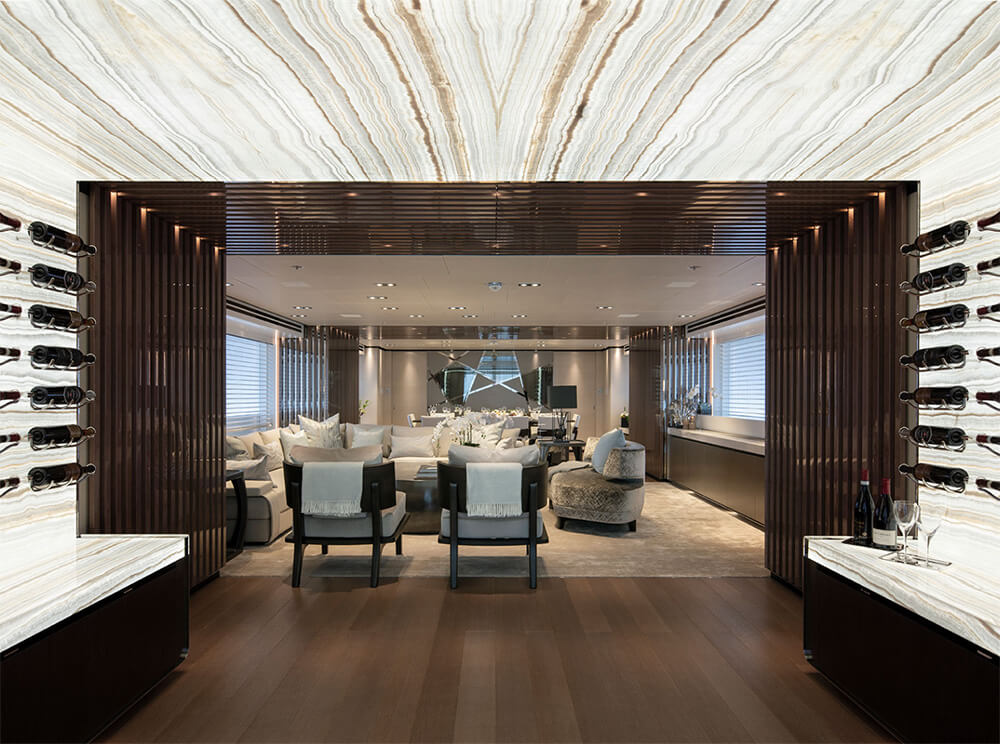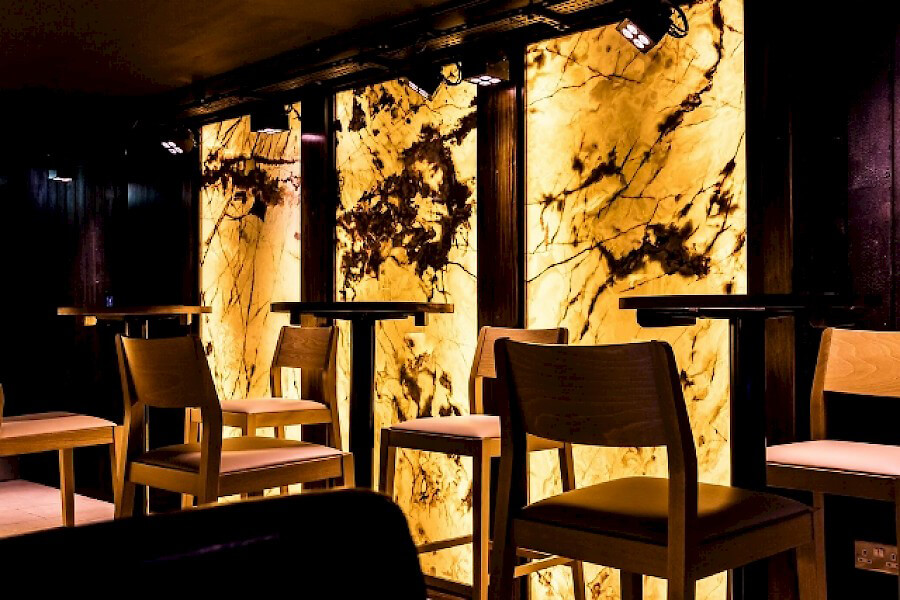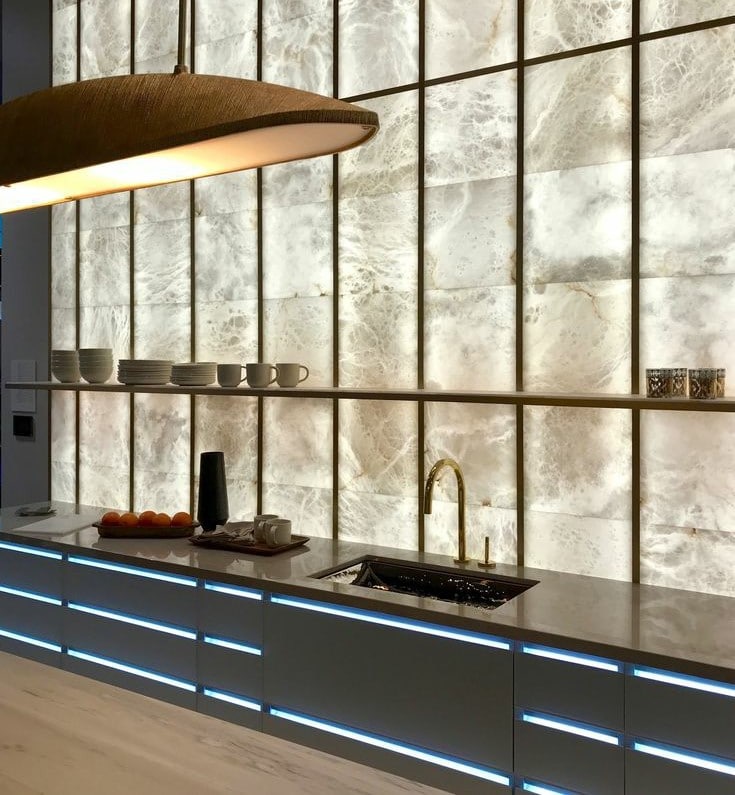Can onyx be backlit, is a question we are often asked. Onyx is one of the most beautiful natural stones that adds a sense of sophistication and elegance to any home project. But another wonderful thing about this natural stone is that it is prized for its translucent qualities, which gives the stone an exotic feel. When you furnish the onyx stone with bright light, it gives off an effervescent and dimensional look that adds to its lustre. And this alone has made the onyx natural stone one of the most popular and sought after choices in the world of designing.
However, can onyx be backlit? Yes, you can enjoy this unique quality of the onyx stone by backlighting it. The onyx appears to be either vibrant or warm- depending on the strength of the backlight source. But one thing is certain: backlighting onyx is a beautiful way to reveal all the beautiful patterns and unique details of this natural stone.
Does light shine through onyx?
As mentioned earlier, onyx is usually translucent and often comes in various colours such as honey, red, and green. Even though polishing your onyx may make it glossy and vibrant, it offers an even more stunning appearance when it is backlit. Due to its generally translucent nature, light can shine through this natural stone or backlight it. In some cases, only some parts of onyx are translucent so that you can shine light through those parts. This is what makes this natural stone so popular in the design world.
However, onyx has more to offer! Onyx also has a rich display of intricate details and complex patterns appearing in waves and circular patterns. These patterns come about purely from how onyx is formed, as it originates in the dripstone deposits of limestone caverns. It also has a wide variety of colours and designs. So, when you shine enough light through it, you can either have a vibrant or warm appearance depending on how translucent the stone is and the degree of lighting you make available. When you backlight a slab of onyx, it takes on a new lease of life, showcasing its beautifully unique designs and patterns. This subtle glow adds an extra touch of elegance to any ambience.
The key to shining enough light through it is by using the right light source. LED panels, for example, can produce an even coverage of light without leaving any dull spots. In addition to the stunning view and range of colours, you can easily use a backlit onyx as the perfect material to create a focal point in any space.

How to put lights under onyx
The first thing you need to do is acquire an onyx stone. There are various options available to choose from. The option that would best suit you would depend on where you want to place your onyx.
Next, you should have a good idea of how many square feet you want to work with for your backlighting project. If you plan to cover more than one surface, make sure you note down the square footage of both surfaces. After this, you would need to research the various translucent onyx types. You’ll find colour options ranging from honey, amber, white, pink, etc. Also, it would be best to appreciate the different options regarding the thickness of the onyx, as this can also affect the degree of illumination. It will be best to have a good look at the slabs available and know how to fit the options you want into your budget. After purchasing your onyx, test it with a backlighting sample to get a good idea of what your finished work will look like. You can also note the needed adjustments before you begin the actual work.
Next, experiment with distances between the light source and the notice. A basic rule of thumb here is that the farther away the light source is from the onyx, the less overall surface brightness you will have. Also, the closer the light source is, the brighter your onyx will be.
However, you need to pay close attention when bringing your light source closer to the onyx. That is because you don’t want the outline of your lighting source to be visible on the onyx, as that will pretty much ruin the effect. You want to have a uniform glow as much as possible, so it’s best to continue experimenting with the distance until you get the desired effect. If you move your light source farther away, the brightness on your overall surface will be less, but you will have a more even spread of light. Move the light source too far away from the onyx, and you will experience very dim or poor illumination.
Be sure to inspect your onyx surface (with the light still on) for any transparent areas. The translucent areas will glow, but transparent portions will make your light source visible, as you can quickly see through them. If some areas on your slab are transparent, you can try blocking the light with an additional layer of translucent material.
It is also worth noting that the backlight application you use will determine how much distance is best. For example, with a countertop slab, you only have a minimum distance available. Walls and other applications offer more comprehensive ranges of distance to work with. You might also want to explore various backlight considerations to find out which option will work best for you. In most cases, your best lighting option is LED that you can customise to your requirements. You can also try out different LED colours, depending on what outcome you want.
Is backlit onyx expensive?
The actual cost of any backlit onyx will depend on the size of the project you are working on (per square metre) and where you want to use your onyx. You will probably appreciate the fact onyx is a luxurious and rare material. Samples of this material are made available on sale or return basis in some cases. You can expect to pay a deposit of £200 or $250 per sample.




